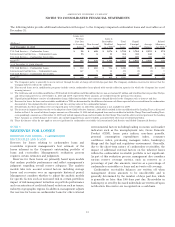American Express 2010 Annual Report Download - page 82
Download and view the complete annual report
Please find page 82 of the 2010 American Express annual report below. You can navigate through the pages in the report by either clicking on the pages listed below, or by using the keyword search tool below to find specific information within the annual report.
CREDIT QUALITY INDICATORS FOR LOANS AND RECEIVABLES
The following table presents the key credit quality indicators for the years ended December 31:
(Millions, except percentages)
Net
Write-Off
Rate
30 Days
Past Due
as a % of
Total
Net
Write-Off
Rate
30 Days
Past Due
as a % of
Total
2010 2009
U.S. Card Services Cardmember Loans 5.8% 2.1% 9.1% 3.7%
U.S. Card Services Cardmember Receivables 1.6% 1.5% 3.8% 1.8%
International Card Services Cardmember Loans 4.6% 2.3% 6.8% 3.3%
(Millions, except percentages)
Net Loss
Ratio as
a%of
Charge
Volume
(a)(b)
90 Days
Past Billing
as a % of
Receivables
(a)
Net Loss
Ratio as
a%of
Charge
Volume
90 Days
Past Billing
as a % of
Receivables
2010 2009
International Card Services Cardmember Receivables 0.24% 1.0% 0.36% 2.1%
Global Commercial Services Cardmember Receivables 0.11% 0.8% 0.19% 1.4%
(a) Effective January 1, 2010, the Company revised the time period in which past due cardmember receivables in International Card Services and Global Commercial
Services are written off to when they are 180 days past due or earlier, consistent with applicable bank regulatory guidance and the write-off methodology adopted for
U.S. Card Services in the fourth quarter of 2008. Previously, receivables were written off when they were 360 days past billing or earlier. The net write-offs for the first
quarter of 2010 include net write-offs of approximately $60 million for International Card Services and $48 million for Global Commercial Services resulting from this
write-off methodology change.
(b) Beginning with the first quarter of 2010, the Company has revised the net loss ratio to exclude net write-offs related to unauthorized transactions, consistent with the
methodology for calculation of the net write-off rate for U.S. Card Services. The metrics for prior periods have not been revised for this change as it was
deemed immaterial.
Refer to Note 5 for other factors, including external environmental factors, that management considers as part of its evaluation process
for reserves for losses.
PLEDGED LOANS AND RECEIVABLES
Certain cardmember loans and receivables totaling
approximately $42.9 billion as of December 31, 2010 are
pledged by the Company to its Lending and Charge Trusts
(including certain loans sold to the Trusts by the Company’s
bank subsidiaries; refer to Note 7).
IMPAIRED LOANS AND RECEIVABLES
Impaired loans and receivables are defined by GAAP as
individual larger balance or homogeneous pools of smaller
balance restructured loans and receivables for which it is
probable that the lender will be unable to collect all amounts
due according to the original contractual terms of the loan and
receivable agreement. The Company considers impaired loans
and receivables to include: (i) loans over 90 days past due still
accruing interest, (ii) non-accrual loans, and (iii) loans and
receivables modified in a troubled debt restructuring (TDR).
The Company may modify cardmember loans and receivables
to minimize losses to the Company while providing
cardmembers with temporary or permanent financial relief.
Such modifications may include reducing the interest rate or
delinquency fees on the loans and receivables and/or placing the
cardmember on a fixed payment plan not exceeding 60 months.
If the cardmember does not comply with the modified terms,
then the loan or receivable agreement generally reverts back to
its original terms. Modification programs can be long-term
(more than 12 months) or short term (12 months or less). The
Company has classified such cardmember loans and receivables
in these modification programs as TDRs.
The performance of a TDR is closely monitored to understand
its impact on the Company’s reserve for losses. Though the
ultimate success of these modification programs remains
uncertain, the Company believes they improve the cumulative
loss performance of such loans and receivables.
Reserves for a TDR are determined by the difference between
cash flows expected to be received from the cardmember
discounted at the original effective interest rates and the
carrying value of the cardmember loan or receivable balance.
80
AMERICAN EXPRESS COMPANY
NOTES TO CONSOLIDATED FINANCIAL STATEMENTS
























